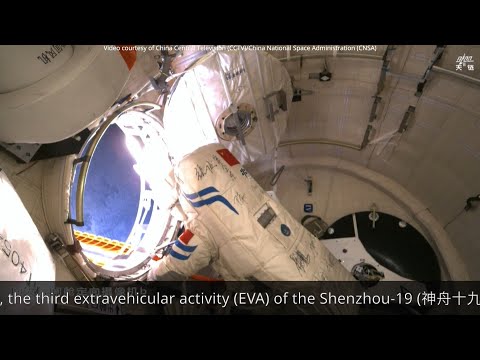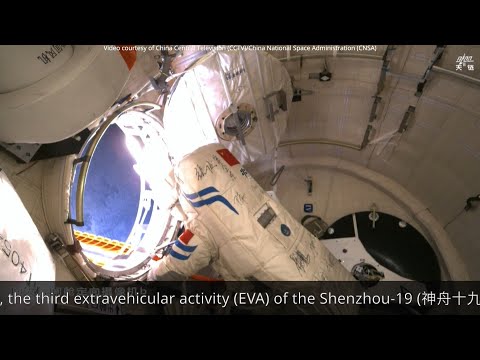Shenzhou-19 Crew Wraps Up Final Spacewalk on Tiangong Station
Can astronauts install complex equipment in space faster than expected?
That’s exactly what happened as China’s Shenzhou-19 crew completed their final spacewalk on the Tiangong space station—finishing critical tasks ahead of schedule and marking a major milestone in their six-month orbital mission.
The mission’s third spacewalk wrapped up the installation of debris shielding on the Wentian module, underscoring China’s growing expertise in long-duration human spaceflight and orbital science.
Final EVA Highlights: What the Shenzhou-19 Crew Achieved
Precision Spacewalk and Advanced Installation
On March 21, astronauts Cai Xuzhe and Song Lingdong stepped outside Tiangong’s Wentian lab module to perform a seven-hour extravehicular activity (EVA). Their main objective? Installing the final orbital debris shielding on the module’s exterior—a vital defense against space hazards.
✓ Completed all external shielding across missions
✓ Installed auxiliary equipment for future EVAs
✓ Inspected key external systems using Tiangong’s robotic arm
“Every procedure was executed on the first try with high precision,” said Wang Yanlei of the China Astronaut Research and Training Center in an interview with CCTV.
Record-Breaking Missions and Team Coordination
A New Benchmark in Chinese Spacewalks
This EVA wasn’t just another task—it marked Cai Xuzhe’s fifth EVA, making him the most experienced Chinese astronaut in terms of spacewalks. The earlier December EVA even lasted 9 hours and 6 minutes, potentially setting a new global endurance record.
Inside Tiangong, astronaut Wang Haoze played a pivotal role, coordinating operations from within—just as she had during the previous two spacewalks.
✓ Seamless ground-to-space communication
✓ Efficient crew collaboration
✓ Task completion ahead of schedule
Pushing Scientific Boundaries in Orbit
Experiments in Space: From Fruit Flies to High-Temperature Materials
Beyond maintenance, the Shenzhou-19 mission also focused on scientific advancement. Over the last five months, the crew conducted a wide range of experiments:
✓ Cultivation of fruit flies and protein crystallization
✓ Studies on five types of human cells
✓ Materials science in containerless and high-temperature labs
“We complement the International Space Station with unique research environments,” noted Wang Yifeng, engineer at the Chinese Academy of Sciences’ Space Utilization Center.
Health Monitoring in Microgravity
Integrating Traditional Chinese and Western Medicine
A standout achievement of this mission is the new astronaut health monitoring system, which fuses traditional Chinese medicine with modern diagnostics. It tracks:
✓ Cardiac health
✓ Bone density and muscle mass
✓ Emotional well-being
This marks a holistic step forward in managing astronaut health during extended space stays.
AI on Board: Meet Xiao Hang
The crew has also worked alongside Xiao Hang (“Little Space”), a small AI-powered robot designed for human-robot interaction in orbit. Xiao Hang supports astronauts during complex operations, reducing mental workload and improving efficiency.
What’s Next: Shenzhou-20 and -21 Crews Ready
Though launch dates remain undisclosed, crews for Shenzhou-20 and Shenzhou-21 have been selected. These missions will continue the six-month rotation format, with Tiangong temporarily housing up to six astronauts during handovers.
Meanwhile, the Long March 2F rocket to launch Shenzhou-21 has already been transported to Jiuquan Satellite Launch Center in northwest China for readiness preparations.
FAQs
Q: What was the main goal of the Shenzhou-19 mission?
A: To complete scientific research and maintenance tasks aboard Tiangong, including installing final debris shielding and testing new health monitoring systems.
Q: Who performed the third spacewalk?
A: Chinese astronauts Cai Xuzhe and Song Lingdong conducted the final EVA of the mission.
Q: How long did the last spacewalk last?
A: The third EVA lasted approximately seven hours, wrapping up crucial installations and inspections.
Q: What is the purpose of the debris shielding?
A: It protects the space station from damage caused by micrometeoroids and orbital debris.
Q: When will Shenzhou-20 and -21 be launched?
A: While exact dates haven’t been confirmed, both missions are scheduled for 2025 and will each last around six months.
Final Thoughts
As Shenzhou-19 nears its return, China’s space program continues to impress with precise operations, expanded research, and seamless teamwork. The question now is—what breakthrough will Tiangong deliver next?
Read our previous article: Are Black Holes Just Cosmic Illusions? New Theory Explains

